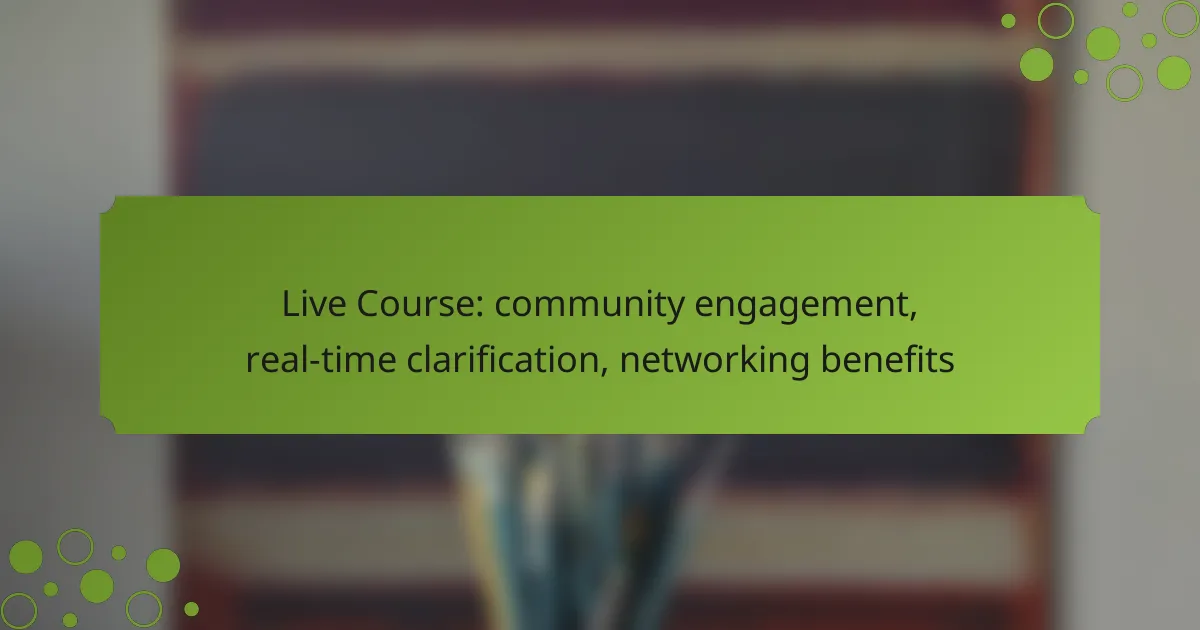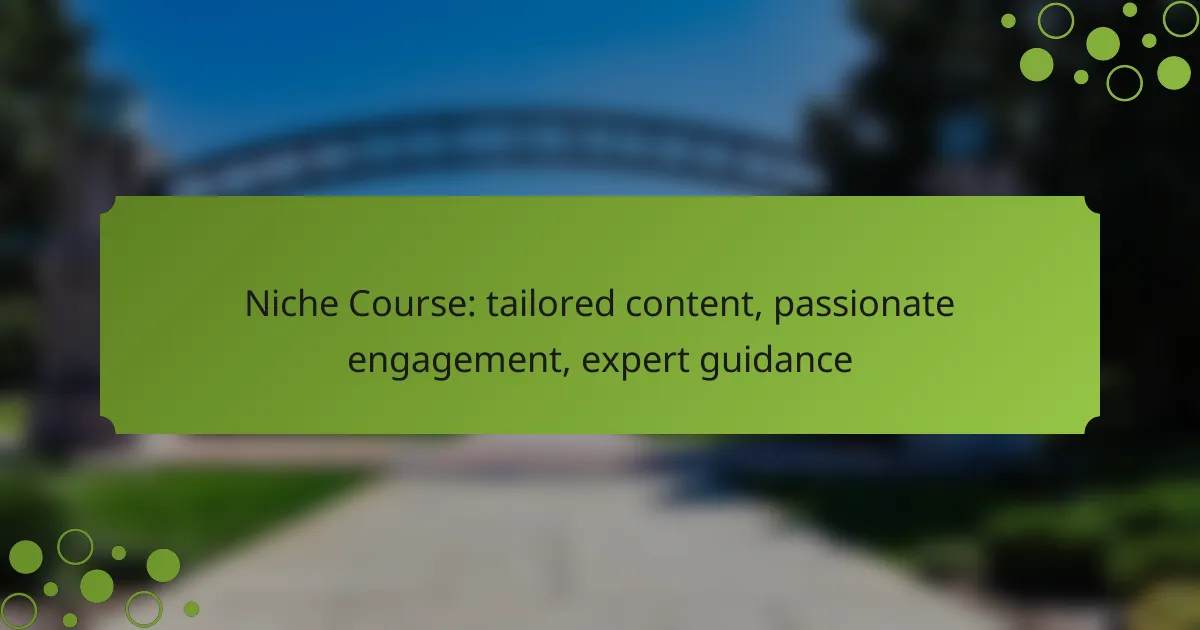Join our live course to experience the power of community engagement, where collaborative learning thrives through active interaction and support among participants. Benefit from real-time clarification that enhances understanding and fosters deeper engagement, while also networking with peers and industry experts to unlock new career opportunities and insights.

How does community engagement enhance learning in live courses?
Community engagement significantly enhances learning in live courses by fostering a collaborative environment where participants can actively interact, share insights, and support each other. This dynamic not only enriches the learning experience but also builds a sense of belonging among learners.
Increased interaction with instructors
In live courses, increased interaction with instructors allows learners to clarify doubts and gain deeper insights into the subject matter. This direct communication can take place through Q&A sessions, live chats, or discussion forums, enabling students to receive immediate responses to their queries.
For example, during a live webinar, participants can ask questions in real-time, which helps to address misunderstandings promptly. This engagement can lead to a more personalized learning experience, as instructors can tailor their responses based on the specific needs of the learners.
Peer collaboration opportunities
Peer collaboration opportunities in live courses encourage learners to work together, share knowledge, and develop critical thinking skills. Group activities, breakout sessions, and collaborative projects allow participants to leverage each other’s strengths and perspectives.
For instance, in a live course on project management, learners might be divided into small groups to tackle a case study. This not only enhances their understanding of the material but also fosters teamwork and communication skills that are essential in professional settings.
Real-time feedback mechanisms
Real-time feedback mechanisms in live courses provide immediate insights into learners’ understanding and progress. Tools such as polls, quizzes, and interactive discussions allow instructors to gauge comprehension and adjust their teaching strategies accordingly.
For example, using instant polls during a session can help instructors identify topics that may need further clarification. This responsiveness ensures that learners stay engaged and can address any challenges they face while the course is still in progress.

What are the networking benefits of live courses in Canada?
Live courses in Canada offer significant networking benefits, allowing participants to connect with peers and industry experts in real time. These interactions foster relationships that can lead to career opportunities, collaborations, and valuable insights.
Access to industry professionals
Participating in live courses provides direct access to industry professionals who share their expertise and experiences. This interaction allows attendees to ask questions and gain insights that are often not available through traditional learning methods.
For example, workshops or seminars led by experts can help attendees understand current trends and best practices in their field. Engaging with these professionals can also open doors to potential job opportunities or collaborations.
Building lasting connections
Live courses facilitate the creation of lasting connections among participants. Networking during these sessions encourages individuals to share their backgrounds, interests, and goals, fostering a sense of community.
By engaging with fellow attendees, participants can form professional relationships that extend beyond the course. These connections can lead to future collaborations, referrals, or even lifelong friendships within the industry.
Opportunities for mentorship
Live courses often provide opportunities for mentorship, connecting participants with experienced professionals who can guide their career development. This mentorship can be invaluable, offering personalized advice and support tailored to individual goals.
Attendees should actively seek out mentors during these courses, as many industry leaders are open to sharing their knowledge and experiences. Establishing a mentorship relationship can significantly enhance one’s professional growth and open up new avenues in their career path.
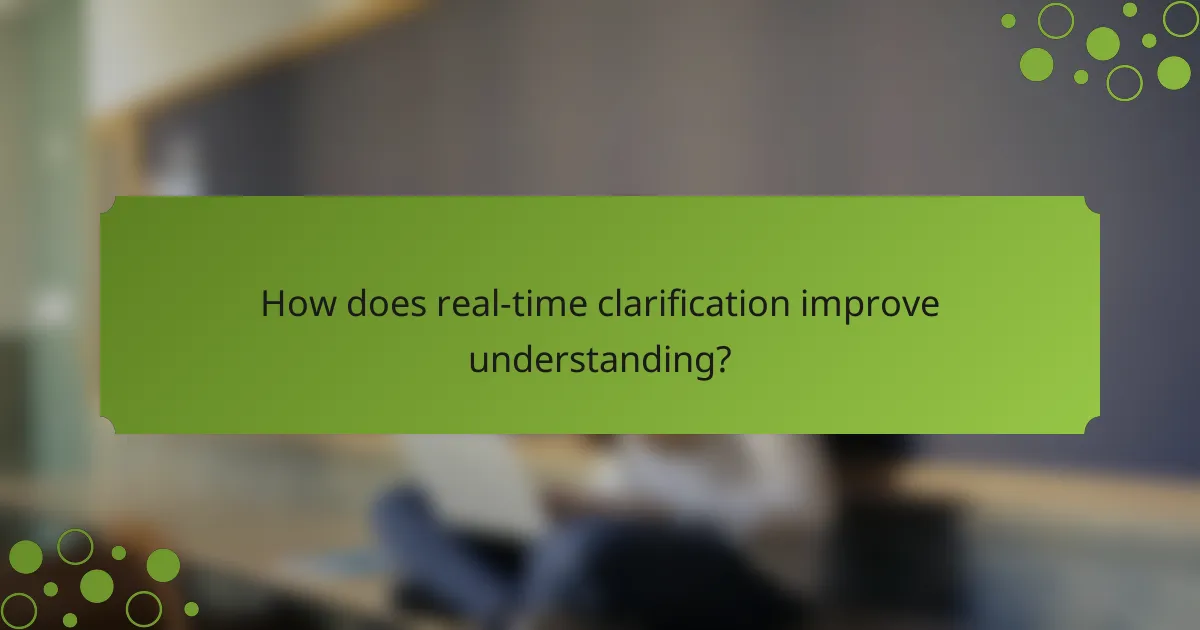
How does real-time clarification improve understanding?
Real-time clarification enhances understanding by allowing participants to receive immediate feedback and answers during discussions. This interactive approach fosters deeper engagement and ensures that concepts are grasped correctly as they are introduced.
Immediate answers to questions
Real-time clarification provides participants with the opportunity to ask questions and receive answers on the spot. This immediate feedback loop helps to clear up confusion before it can hinder learning. For example, if a participant is unsure about a term used in a lecture, they can ask for clarification right away rather than waiting until the end.
In a live course setting, this can significantly enhance the learning experience, as participants feel more empowered to engage and contribute. This immediacy can lead to a more dynamic and interactive environment, encouraging open dialogue.
Enhanced retention of information
When learners receive real-time clarification, they are more likely to retain information effectively. Immediate responses help solidify understanding, making it easier for participants to remember key concepts. For instance, when a participant asks a question and receives a clear answer, the connection between the question and the information is reinforced.
Additionally, engaging with the material through questions can create a more memorable learning experience. Techniques such as summarizing answers or relating them to real-world scenarios can further enhance retention.
Reduction of misconceptions
Real-time clarification helps reduce misconceptions by addressing misunderstandings as they arise. When participants can clarify doubts immediately, they are less likely to leave with incorrect interpretations of the material. This proactive approach is crucial in preventing the spread of misinformation within a learning community.
For example, if a participant misinterprets a key concept, real-time clarification allows the instructor to correct this misunderstanding right away. This not only benefits the individual learner but also contributes to a more accurate collective understanding among all participants.
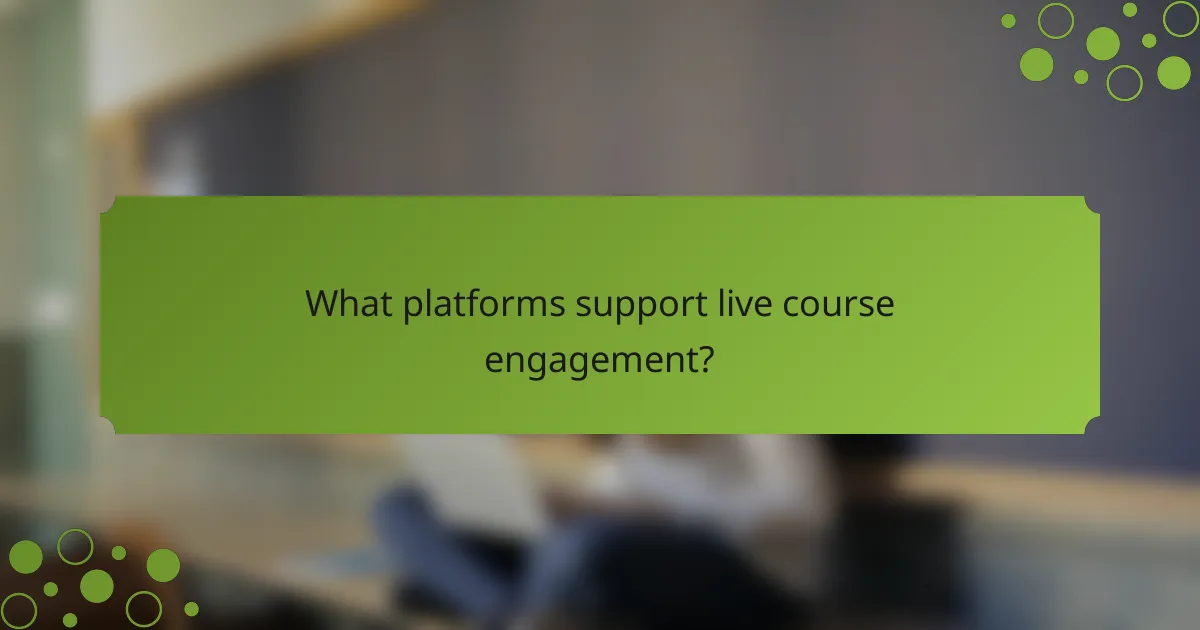
What platforms support live course engagement?
Several platforms facilitate live course engagement, each offering unique features that enhance interaction, management, and community building. Choosing the right platform depends on your specific needs for real-time communication, course organization, and community discussions.
Zoom for interactive sessions
Zoom is widely used for live interactive sessions, allowing instructors and students to engage in real-time discussions. Features like breakout rooms enable small group interactions, fostering collaboration and deeper engagement among participants.
To maximize the effectiveness of Zoom, consider scheduling sessions at times that accommodate most participants. Utilize polls and Q&A features to encourage participation and gather feedback during the session.
Moodle for course management
Moodle serves as a robust platform for course management, providing tools for organizing content, tracking progress, and assessing student performance. Its integration with various plugins allows for enhanced functionality, such as quizzes and forums.
When using Moodle, ensure that course materials are clearly structured and accessible. Regularly update content and utilize the grading features to keep students informed about their progress and areas for improvement.
Slack for community discussions
Slack is an excellent tool for fostering community discussions, offering channels for specific topics and direct messaging for quick communication. This platform encourages informal interactions, which can enhance relationships among participants.
To effectively use Slack, create dedicated channels for different subjects or projects and encourage participants to share resources and insights. Be mindful of managing notifications to prevent information overload, ensuring that discussions remain productive and focused.
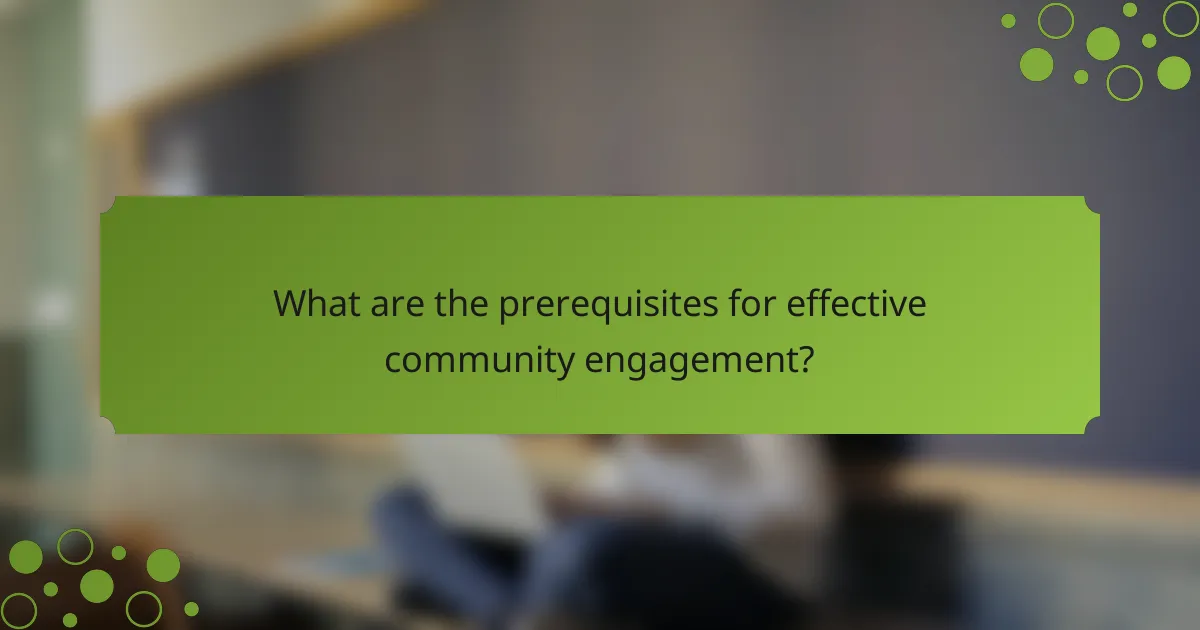
What are the prerequisites for effective community engagement?
Effective community engagement requires clear communication and defined objectives. These prerequisites ensure that participants understand their roles and the goals of the engagement process, leading to more meaningful interactions.
Clear communication guidelines
Establishing clear communication guidelines is essential for fostering effective community engagement. This includes defining the channels of communication, the tone to be used, and the frequency of updates. For example, using a dedicated online platform can streamline interactions and keep everyone informed.
Additionally, it is important to set expectations regarding response times and the types of feedback that are encouraged. Providing examples of constructive feedback can help participants engage more effectively. Regularly revisiting and updating these guidelines can also enhance clarity as the community evolves.
Defined objectives for participation
Defined objectives for participation help participants understand what is expected of them and what they can achieve through engagement. These objectives should be specific, measurable, achievable, relevant, and time-bound (SMART). For instance, a community project may aim to increase local volunteerism by 20% within six months.
Moreover, clearly articulated objectives can motivate participants by showing them the impact of their contributions. It’s beneficial to communicate these goals at the outset and revisit them periodically to maintain focus and momentum. Avoid vague objectives that can lead to confusion and disengagement among community members.
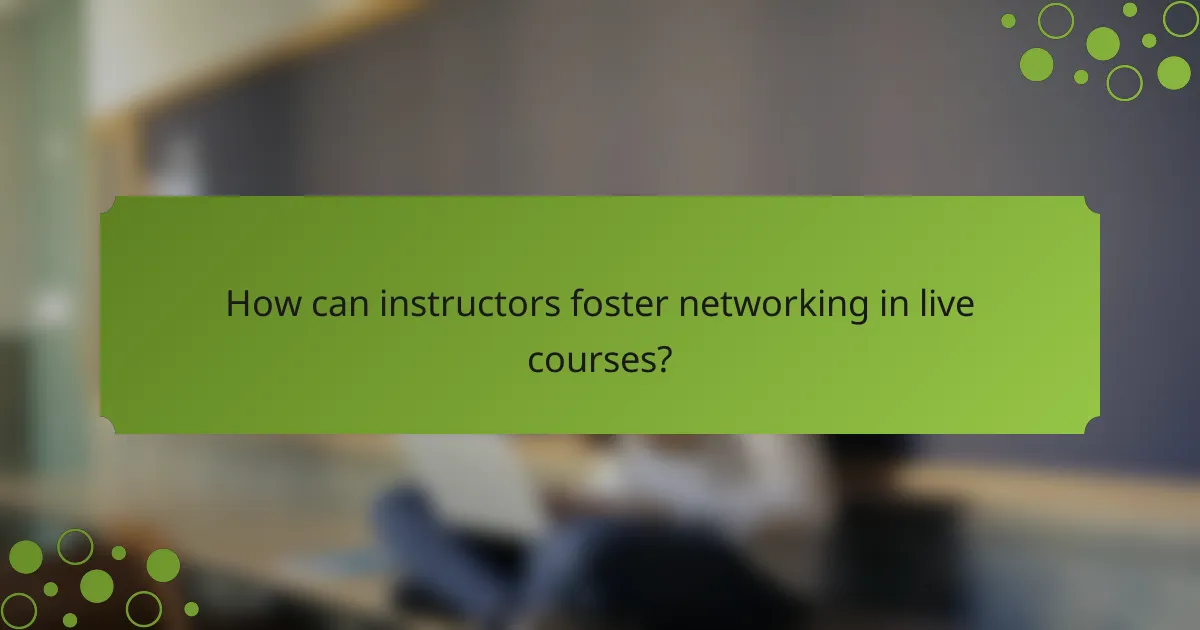
How can instructors foster networking in live courses?
Instructors can enhance networking in live courses by creating structured opportunities for interaction and collaboration among participants. This approach not only builds relationships but also enriches the learning experience through shared insights and connections.
Structured networking activities
Structured networking activities are designed to facilitate connections between participants in a focused manner. These can include icebreaker games, speed networking sessions, or themed discussions that encourage attendees to share their backgrounds and expertise.
For effective structured networking, consider setting clear objectives for each activity. For example, allocate 10-15 minutes for icebreakers at the start of a session to help participants feel comfortable and engaged. This time frame allows for meaningful interactions without overwhelming attendees.
Incorporating tools like breakout rooms in virtual settings can help manage group sizes and foster more intimate conversations. Ensure that participants know the purpose of each activity to maximize engagement and networking potential.
Facilitated breakout sessions
Facilitated breakout sessions provide smaller groups with the opportunity to dive deeper into specific topics while networking. Instructors can guide these sessions, ensuring that discussions remain productive and relevant.
When organizing breakout sessions, aim for groups of 4-6 participants to encourage participation from everyone. Assign a clear topic or question for discussion, and provide a time limit of around 20-30 minutes to keep the momentum going. This structure allows for focused dialogue and the chance for participants to connect over shared interests.
After the breakout sessions, reconvene as a larger group to share key takeaways. This not only reinforces learning but also allows participants to network further by discussing insights gained from different groups.

What are the emerging trends in live course engagement?
Emerging trends in live course engagement focus on enhancing interactivity, fostering community connections, and leveraging real-time feedback. These trends aim to create a more immersive learning experience that benefits both instructors and participants.
Community engagement
Community engagement in live courses involves creating a collaborative environment where participants feel connected and valued. This can be achieved through discussion forums, group projects, and social media integration, allowing learners to share insights and support each other.
To foster community engagement, consider using platforms that facilitate real-time interactions, such as chat features or breakout rooms. Encourage participants to introduce themselves and share their goals, which can help build rapport and a sense of belonging.
Real-time clarification
Real-time clarification allows participants to ask questions and receive immediate feedback during live courses. This instant interaction helps clarify complex topics and enhances understanding, making the learning process more effective.
Incorporating tools like live polls, Q&A sessions, and interactive quizzes can facilitate real-time clarification. Ensure that instructors are prepared to address questions promptly, as this responsiveness can significantly improve participant satisfaction and retention.
Networking benefits
Networking benefits in live courses provide participants with opportunities to connect with peers and industry professionals. These connections can lead to collaborations, mentorships, and career advancements, making the course experience more valuable.
Encourage networking by organizing virtual meet-and-greets, discussion panels, or collaborative projects. Highlighting the importance of building professional relationships can motivate participants to engage more actively and leverage their networks effectively.
